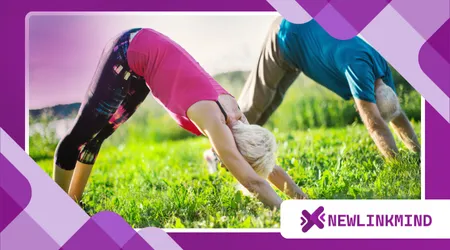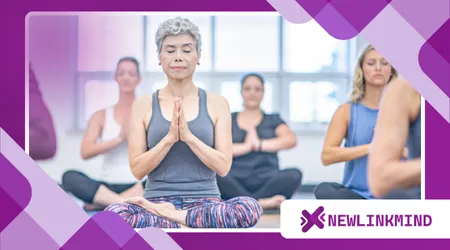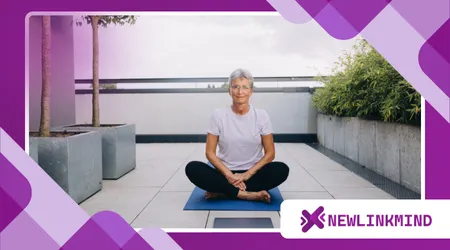Yoga for Seniors: Finding the Right Style for You

Anúncios
Yoga for seniors. Yoga, at its core, is a union—a connection between breath, body, and spirit. For seniors, this connection often translates into improved mobility and a calmer mind.
It’s a practice that meets you exactly where you are, adapting to individual capabilities rather than demanding adherence to a rigid ideal.
Many assume yoga requires pretzel-like flexibility, but that’s a common misconception. Gentle movements are often more beneficial, focusing on strengthening core muscles.
Regular practice can significantly reduce the risk of falls, a major concern for older adults.
The breath work, or pranayama, is equally important. Conscious breathing calms the nervous system, reducing stress and anxiety.
Anúncios
This aspect alone can profoundly impact daily life, fostering a sense of tranquility.
Beyond the physical, yoga cultivates mental clarity. It encourages mindfulness, bringing awareness to the present moment.
This focus can alleviate the mental clutter that often accompanies an active life.
Anúncios
Navigating the Diverse Landscape of Yoga Styles
Choosing the right style is paramount for a fulfilling yoga for seniors experience.
There isn’t a one-size-fits-all solution; what works for one person might not suit another. Exploration is key to finding your perfect match.
Gentle Hatha: A Foundation for All
Hatha yoga, known for its slower pace and foundational poses, serves as an excellent starting point. It emphasizes holding poses for a few breaths, allowing for proper alignment.
This deliberate approach builds strength and flexibility gradually, minimizing strain.
It’s an ideal choice for beginners or those seeking a less strenuous practice.
Read more: How to Build a Home Yoga Practice as a Senior
Modifications are easily incorporated, using props like chairs, blocks, and straps to support the body. This adaptability makes it highly accessible.
Classes typically focus on a series of basic postures, combined with breathing exercises.
The unhurried pace allows ample time to understand each movement. This style lays a solid groundwork for deeper exploration.

Restorative Yoga: Deep Relaxation and Healing
Restorative yoga is all about surrender and deep relaxation. Poses are held for extended periods, usually 5 to 20 minutes, with ample support from bolsters, blankets, and eye pillows.
The goal is to release tension and activate the parasympathetic nervous system.
This style is particularly beneficial for managing chronic pain, reducing stress, and improving sleep quality.
It’s a profoundly calming experience, often leading to a sense of rejuvenation. It’s less about movement and more about stillness.
Imagine floating effortlessly, completely supported, as your body unwinds.
This experience helps to reset your system, offering a sanctuary from daily pressures. It’s a therapeutic approach that prioritizes comfort.
Chair Yoga: Accessible and Empowering
Chair yoga is a revolutionary approach, making the practice accessible to almost everyone, regardless of mobility limitations.
As the name suggests, many poses are performed while seated, or using the chair for support. This reduces the weight-bearing demands.
It’s perfect for individuals with limited mobility, balance issues, or those recovering from injuries.
The chair provides stability, allowing participants to experience the benefits of yoga safely. You can still engage core muscles and improve flexibility.
See how interesting: Morning vs. Evening Meditation for Seniors: What Works Best?
For example, a gentle chair twist can improve spinal mobility without the risk of falling.
Leg lifts performed while seated strengthen the quadriceps. This innovation truly opens the door for widespread participation.
Kundalini Yoga: Energy and Awareness
Kundalini yoga focuses on awakening energy within the body through dynamic movements, breathwork, and chanting.
While some aspects might seem intense, many exercises are suitable for seniors, particularly the breath patterns and meditations.
It’s often practiced with a focus on specific energy centers, or chakras. This style can be invigorating, fostering a sense of vitality and mental clarity.
It’s less about physical prowess and more about internal experience.
This style is excellent for those looking to explore the spiritual dimensions of yoga. It can be adapted, and many teachers offer modified sets of exercises. It’s a journey of self-discovery through energy flow.
Tai Chi: A Gentle Flowing Complement
While not strictly yoga, Tai Chi shares many principles and offers similar benefits. Its slow, flowing movements enhance balance, coordination, and mental focus.
Often described as “meditation in motion,” it’s highly recommended for seniors.
Tai Chi promotes a gentle strengthening of muscles and joints, improving flexibility without impact.
It’s a beautiful complement to a yoga practice, offering a different form of mindful movement. The continuous, circular motions are deeply calming.
For instance, the “Grasping the Sparrow’s Tail” sequence in Tai Chi improves weight transference and balance, critical skills for preventing falls.
This ancient art fosters a sense of inner harmony and physical grace.
The Transformative Benefits: Beyond the Mat
The advantages of practicing yoga for seniors extend far beyond the physical postures.
It’s a holistic practice that nurtures every aspect of your being. The ripple effect of regular participation can profoundly improve quality of life.
Read here: Meditation Breaks vs. Coffee Breaks: Which Is Better?
One of the most significant benefits is improved balance.
A study published in the Journal of the American Geriatrics Society in 2017 found that older adults who practiced yoga regularly experienced a significant reduction in fall rates compared to a control group.

This tangible improvement highlights the practical impact of the practice.
| Benefit Area | Specific Impact |
| Physical Health | Increased flexibility, strength, and balance |
| Mental Clarity | Reduced stress, improved focus, and cognitive function |
| Emotional Well-being | Enhanced mood, reduced anxiety, and greater resilience |
| Social Connection | Opportunity to connect with a supportive community |
Beyond statistics, consider the anecdotal evidence. Imagine a retired teacher, once hesitant to climb stairs, now easily navigating her grandchildren’s home after months of consistent yoga.
Or a former executive, plagued by insomnia, finally enjoying restful nights thanks to restorative practices. These real-life transformations underscore yoga’s profound impact.
Yoga acts like a gentle river, steadily carving its path, smoothing rough edges, and nourishing the landscape.
It patiently sculpts strength and serenity, one breath at a time. It’s not about instant gratification, but sustained, gradual improvement.
Finding Your Perfect Instructor and Community
The instructor plays a pivotal role in your yoga for seniors journey.
Look for teachers with experience working with older adults, who understand modifications and individual needs. A good instructor creates a welcoming and safe environment.
Don’t hesitate to try different classes or studios. Each teacher has a unique style, and finding one that resonates with you is crucial. Word-of-mouth recommendations can also be valuable.
Consider the atmosphere of the class. Do you feel comfortable and supported? A sense of community can significantly enhance your experience.
Sharing this journey with others often provides an additional layer of motivation and enjoyment.
Embracing the Journey: A Path to Lifelong Well-being
Starting a yoga practice is an investment in your future self. It’s an act of self-care that yields profound dividends.
There’s no pressure to be perfect; the essence is in the consistent effort and the journey itself.
Remember, consistency trumps intensity. Even short, regular sessions are more beneficial than sporadic, strenuous ones. Listen to your body and honor its wisdom.
Is it not remarkable how ancient practices continue to offer relevant solutions to modern challenges, particularly as we seek sustained vitality in our later years?
Yoga truly empowers seniors to live more fully. Embrace the process, celebrate small victories, and discover the immense joy that awaits on your mat.
Frequently Asked Questions
Is yoga safe for seniors with health conditions?
Yes, in most cases, but it’s crucial to consult your doctor before starting any new exercise program, especially if you have pre-existing health conditions or injuries.
Many yoga styles can be adapted to accommodate various needs.
How often should seniors practice yoga?
Consistency is more important than duration. Aim for at least 2-3 times per week, even if for shorter sessions (20-30 minutes). Daily short practices can also be very beneficial.
What should I wear for a yoga class?
Wear comfortable, loose-fitting clothing that allows for a full range of motion. Avoid anything too restrictive.
Do I need special equipment to start?
Initially, you only need comfortable clothing. Many studios provide mats and props. If practicing at home, a non-slip mat is recommended.
Props like blocks, straps, and bolsters can enhance your practice but aren’t essential at the very beginning.
Can yoga help with arthritis?
Yes, gentle yoga can significantly help manage arthritis symptoms by improving joint flexibility, reducing stiffness, and strengthening supporting muscles.
However, always listen to your body and avoid movements that cause pain.
++ 7 Different Kinds of Yoga and How To Find the Right Practice
